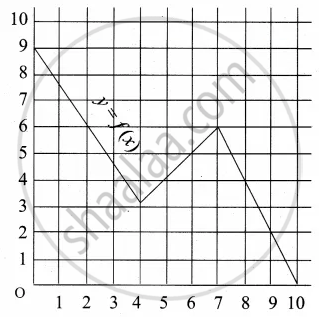Advertisements
Advertisements
Question
If f : R → R be defined by f(x) = x2 + 1, then find f−1 [17] and f−1 [−3].
Solution
If f : A → B is such that y ∈ B, then \[f^{- 1}\] { y }={x ∈ A: f (x) = y}.
In other words, f -1{ y} is the set of pre - images of y.
Let
Then, f (x) =17 .
⇒ x2 +1 = 17
⇒ x2 = 17 -1 = 16
⇒ x = ± 4
∴ \[f^{- 1}\] {17} = { -4,4}
Then, f (x) =-3
⇒ x2 + 1 = -3
⇒ x2 =- 3 - 1 = -4
So
APPEARS IN
RELATED QUESTIONS
Let f be the subset of Z × Z defined by f = {(ab, a + b): a, b ∈ Z}. Is f a function from Z to Z: justify your answer.
A function f : R → R is defined by f(x) = x2. Determine (a) range of f, (b) {x : f(x) = 4}, (c) [y: f(y) = −1].
The function f is defined by \[f\left( x \right) = \begin{cases}x^2 , & 0 \leq x \leq 3 \\ 3x, & 3 \leq x \leq 10\end{cases}\]
The relation g is defined by \[g\left( x \right) = \begin{cases}x^2 , & 0 \leq x \leq 2 \\ 3x, & 2 \leq x \leq 10\end{cases}\]
Show that f is a function and g is not a function.
If f(x) = (a − xn)1/n, a > 0 and n ∈ N, then prove that f(f(x)) = x for all x.
Let f and g be two real functions defined by \[f\left( x \right) = \sqrt{x + 1}\] and \[g\left( x \right) = \sqrt{9 - x^2}\] . Then, describe function:
(v) \[\frac{g}{f}\]
Let f and g be two real functions defined by \[f\left( x \right) = \sqrt{x + 1}\] and \[g\left( x \right) = \sqrt{9 - x^2}\] . Then, describe function:
(vi) \[2f - \sqrt{5} g\]
If f, g and h are real functions defined by
Write the domain and range of the function \[f\left( x \right) = \frac{x - 2}{2 - x}\] .
The function f : R → R is defined by f(x) = cos2 x + sin4 x. Then, f(R) =
If f(m) = m2 − 3m + 1, find f(− x)
Which of the following relations are functions? If it is a function determine its domain and range:
{(1, 1), (3, 1), (5, 2)}
If f(x) = `{(x^2 + 3"," x ≤ 2),(5x + 7"," x > 2):},` then find f(0)
Find x, if g(x) = 0 where g(x) = `(18 -2x^2)/7`
Express the area A of circle as a function of its diameter d
Check the injectivity and surjectivity of the following function.
f : N → N given by f(x) = x3
Express the following exponential equation in logarithmic form
54° = 1
Express the following exponential equation in logarithmic form
e2 = 7.3890
Express the following logarithmic equation in exponential form
log2 64 = 6
Write the following expression as sum or difference of logarithm
In `[(root(3)(x - 2)(2x + 1)^4)/((x + 4)sqrt(2x + 4))]^2`
Solve for x.
log2 x + log4 x + log16 x = `21/4`
Solve for x.
x + log10 (1 + 2x) = x log10 5 + log10 6
If `log(( x - y)/4) = logsqrt(x) + log sqrt(y)`, show that (x + y)2 = 20xy
If f(x) = 3x + 5, g(x) = 6x − 1, then find (f − g) (2)
Answer the following:
Identify the following relation is the function? If it is a function determine its domain and range.
{(0, 0), (1, 1), (1, –1), (4, 2), (4, –2), (9, 3), (9, –3), (16, 4), (16, –4)}
Answer the following:
A function f is defined as : f(x) = 5 – x for 0 ≤ x ≤ 4. Find the value of x such that f(x) = 5
Answer the following:
If f(x) = 3x + a and f(1) = 7 find a and f(4)
Answer the following:
Solve for x, logx (8x – 3) – logx 4 = 2
Given the function f: x → x2 – 5x + 6, evaluate f(2a)
Given the function f: x → x2 – 5x + 6, evaluate f(x – 1)
A graph representing the function f(x) is given in it is clear that f(9) = 2

Describe the following Domain
A function f is defined by f(x) = 2x – 3 find x such that f(x) = 0
The data in the adjacent table depicts the length of a person's forehand and their corresponding height. Based on this data, a student finds a relationship between the height (y) and the forehand length (x) as y = ax + b, where a, b are constant.
| Length ‘x’ of forehand (in cm) |
Height 'y' (in inches) |
| 35 | 56 |
| 45 | 65 |
| 50 | 69.5 |
| 55 | 74 |
Find a and b
Domain of function f(x) = cos–1 6x is ______.
Let f : R → R be defined by
f(x) = `{(3x; x > 2),(2x^2; 1 ≤ x ≤ 2), (4x; x < 1):}`
Then f(-2) + f(1) + f(3) is ______
Find the domain for which the functions f(x) = 2x2 – 1 and g(x) = 1 – 3x are equal.
Find the domain of the following functions given by f(x) = `1/sqrt(1 - cos x)`
If f(x) = y = `(ax - b)/(cx - a)`, then prove that f(y) = x.
The domain and range of the function f given by f(x) = 2 – |x – 5| is ______.
If f(x) = x3 – 1 and domain of f = {0, 1, 2, 3}, then domain of f–1 is ______.
The period of the function
f(x) = `(sin 8x cos x - sin 6x cos 3x)/(cos 2x cos x - sin 3x sin 4x)` is ______.
